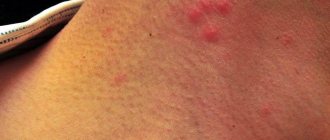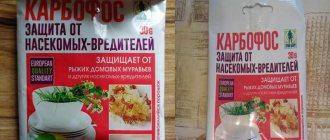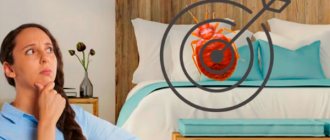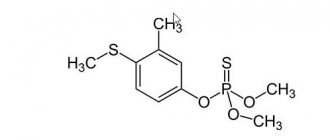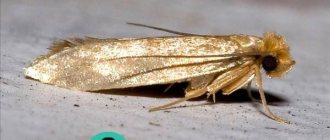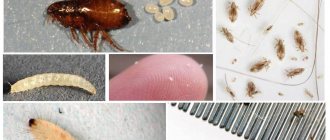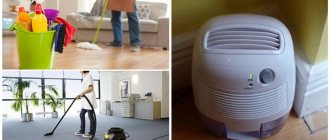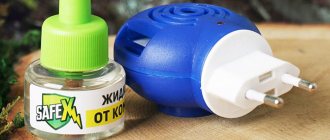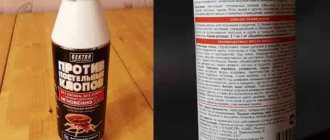They are popular because they are effective and will penetrate almost anywhere. They have a prolonged insecticidal effect; treated surfaces remain fatal to parasites. Using these products, you will save a lot of money; one 50 mg bottle (this is a typical packaging) is enough to make a two-room apartment suitable for comfortable living again. Supplied in the form of water-soluble emulsions. Each of them is based on a substance that destroys the bloodsucker’s nervous system. To apply, use a brush or spray bottle, treat the habitats and places of movement of bedbugs. Before processing, remove people, animals and food from the room, and when finished, ventilate.
Get Total
We advise you to pay attention to this product with a neuroparalytic effect - chlorpyrifos does not misfire. You and your loved ones may feel completely safe, but the bedbugs will surely die. Moreover, pests will not enter your home for at least a year and a half; this is the period of residual action. There are no stains left after applying the insecticide.
Practice is the criterion of truth, as is known. Recommended products have been tested in practice. Choose the right product for you based on the situation, strictly follow the instructions in the instructions for use.
Application
Destruction of adults and larvae of arthropods:
use freshly prepared emulsions in concentrations of 1-0.035% according to the DV at a flow rate of working aqueous solutions of 100 ml/m 2.
Destruction of cockroaches:
use 1.00% DV (25 times dilution), selectively treating surfaces in places where insects are detected, localized and along the paths of movement of insects. Treatment is carried out simultaneously in all rooms inhabited by cockroaches.
Destruction of ants:
to destroy red house ants and other species of ants that often enter rooms, treat travel routes (“paths”) or places of accumulation. The working emulsion used is 0.5% according to the DV (50 times dilution).
Destruction of bedbugs:
To kill bedbugs, use 0.50% DV (50 times dilution) aqueous emulsions of the drug. If the premises are sparsely populated, only their habitats are treated with bed bugs; If there is a large population and if the walls are covered with dry plaster, the places of their possible settlement must also be treated. Do not treat bedding!
Destruction of fleas:
to kill fleas, use 0.25% (DV) working aqueous emulsion (100-fold dilution).
When treating cluttered basements, these rooms are first cleared of debris and then thoroughly irrigated.
Killing flies:
to destroy imagoes of house flies or other species of flies, use a 0.25% (DV) working aqueous emulsion (100-fold dilution). To destroy fly larvae, their breeding sites (cesspools, waste, food waste) are treated with 0.1% (DV) emulsion (diluted 250 times) at intervals of 1 time every 20-30 days. The consumption rate is 1 l/m2 for waste thickness up to 50 cm. When processing cesspools 3-5 m deep, the consumption is increased to 5-10 l per 1 m2.
Killing mosquitoes:
to destroy adult mosquitoes, use 0.06% (according to the DV) working aqueous emulsion; to destroy mosquito larvae, use 0.035% (according to the DV) aqueous emulsions. The consumption rate is 100 ml per 1 sq.m. water surface. Destruction of rat mites: to destroy rat mites, use a 0.50% (DV) aqueous emulsion (50 times diluted). Repeated treatment is carried out according to indications, but not earlier than 10-15 days after the first. When treating natural habitats to combat ixodid ticks, the application rate ranges from 2 kg/ha (I. Persulcatus) to 4.5 kg/ha (Dermacentor). Residual effect is up to 1.5 months.
Rely on the sanitary and epidemiological station, but don’t make a mistake yourself: methods of control at home
After conducting a thorough investigation, you are convinced of the presence of bedbugs. Ignoring the panic and horror, pull yourself together and draw up a clear plan of action to wisely distribute your funds and strength.
It is important to decide:
- what product to choose to combat bedbugs;
- in what form it is produced and sold;
- how dangerous is this remedy;
- what poison does it contain?
The poison comes to store shelves in ready-made mixtures. They all contain poisons or a combination of them in different percentages:
- Powder (Dust) is a finely ground dry mixture. The active substance is present in an amount of 1–10% . The remaining part consists of fillers - boric acid and a certain proportion of lubricating oil, which ensures that the powder sticks to the insect. Does not require preliminary preparation. Open the package and sprinkle significant areas. It is convenient to use a brush or sponge, or a rubber bulb. We use gloves, a respirator, and safety glasses. The presence of healthy, active children and pets while we wait for the drug to take effect gives the powder additional movement around the apartment.
- Gel/chalk is a paste or compressed mixture of insecticide with various fillers. Serves to draw boundaries beyond which the presence of parasites is undesirable. You will have to draw frequently - most insecticides are light sensitive.
- Emulsion or solution - a concentrate of the active substance in a liquid up to 50% . The active substance can be one or several poisons at the same time. Requires preparation of the solution and serious safety measures when working with it. Rubber gloves, safety glasses, a respirator and clothes that you don’t mind throwing away.
- Aerosol is a ready-to-use mixture under pressure. Used for visually observable individuals. Forms a dense gas-droplet cloud .
- The trap is useless in the fight against bedbugs. The bug is exclusively interested in warm living blood.
Bed bugs appeared in the house: main reasons
Evidence-based statistics claim that only three out of ten people can feel the bites of this blood-sucking insect . Find and destroy is our task.
The cleanliness of the owners has little effect on the appearance of unexpected guests. It is important to calm down and analyze which of the events have recently occurred in your life:
- You moved to another apartment or someone moved in with your belongings.
- We also bought good furniture or office equipment.
- You live next to an apartment where the clan of bedbugs has grown significantly, they began to starve and emigrate to undeveloped territories. Bed bugs also move well on the outer walls of the house.
- We stayed in a hotel in some exotic country, traveled, visited hard-to-reach and unusual places. And they brought the insect in clothes, a box, a picture, a stuffed animal or a book.
I thought bedbugs in an apartment were a thing of the forgotten past, well, maybe, except for old wooden barracks, prisons, etc... It turns out that this problem exists, and not only in our city, and you don’t need to have “special” neighbors - one of The main reasons for the appearance of bedbugs in an apartment these days are tourist trips, especially to Asian countries, which are more preferred by Far Easterners. We bring these “bloodsuckers” from hotels in Thailand, China, etc. Therefore, immediately after traveling, it is necessary to wash all things from suitcases (dirty, clean) at a temperature above 45 degrees (I, in fact, always do this). Another source of bedbugs in an apartment is a dacha. Bedbugs live in nature, including in a dacha, and to the dacha, we usually take old furniture and things - the favorite habitat of these insects. Pets can also carry bedbugs.
City girl
https://www.komcity.ru/forum/home/?id=48940&page=2
How to determine the danger of an insecticide
All substances used to kill insects are poisonous. The lowest concentration of poison in herbal preparations. But a serious problem cannot be solved with such a drug.
The more effective a drug is, the more toxic it is. But he who is warned is protected. The manufacturer is required to indicate the hazard class of the insecticide on the packaging of its products.
Hazard classes of insecticides - table
| Hazard class, GOST | Danger level |
| 1 | Extremely dangerous |
| 2 | Highly dangerous |
| 3 | Moderately dangerous |
| 4 | Low hazardous substances |
Anti-bedbug Executioner
A drug with such a simple name hit the shelves of Russian markets relatively recently - in 2013 and, according to many sources, has earned widespread recognition, primarily due to its low price and absolute safety for warm-blooded animals, that is, for humans and domestic animals. The executioner is a tool originally made in Germany, which appeared on the Russian market. Today, one bottle of Executioner, with a capacity of 5 to 10 ml, can be purchased from various distributors at a price of 70 to 100 rubles. One such bottle is enough, diluted with 0.5 or 1.0 liters of water at room temperature, respectively. You can treat a space of about 5-10 square meters with this amount. m. To treat the room you need to purchase more bottles.
After treatment with Executioner, bedbugs do not return for several months. To further repel them, it is recommended to use additional repellents, for example, fragrant essential oils of plants.
How things really are
Before believing such bold advertising claims, let's first try to look into the chemical composition of the Executioner product. The working substance that acts as a direct weapon against bed bugs, which is part of the Executioner, is called fenthion.
What is fenthion?
Fenthion is an organothiophosphate insecticide and acaricide, meaning it is lethal to insects and arachnids. Among the unique properties, a highly toxic effect on birds has been revealed - an avicidal effect. Bed bugs are classified as insects, so fenthion will definitely kill them. Like most other organophosphorus compounds, the mechanism of toxic action of fenthion is based on inhibition of cholinesterase. This is an enzyme that promotes the transmission of nerve impulses from neuron to neuron; without this enzyme, such a process is impossible, all vital processes of the insect are suppressed, and it dies.
Due to its relatively low toxicity to humans and other mammals, fenthion is listed as a moderately toxic compound with a moderate toxicity rating by the World Health Organization. This means that all drugs that contain fenthion are allowed to be used in residential premises, but in compliance with all the principles of personal safety and hygiene. Accidental or intentional entry into the digestive system or respiratory tract will cause poisoning. In addition, fenthion has the ability to be absorbed through the skin and mucous membranes. This should also be remembered by those who treat the premises against bedbugs.
And this is also not a real Executioner product, not from the manufacturer
Fenthion is a contact and internal insecticide that is actively used against many sucking and biting pests. It is especially effective against fruit flies, leaf caterpillars, grain bugs, bark beetles, mosquitoes, all external parasites of animals, ticks, aphids, apple moths and other types of insects that harm humans.
Fenthion is widely used in agriculture and is found in a wide variety of commercial treatments, both in liquid and dry form. It is especially often used in the cultivation of sugar cane, rice, corn, beets, pome and stone fruits, citrus fruits, pistachios, cotton, olives, coffee, cocoa, vegetables and grapes. Thus, it can be used on almost any fruit several months before they ripen and are eaten.
Based on its high toxicity against birds, fenthion has been used in some cases to control bird populations in many parts of the world where it has been required. The substance is also used in livestock production as an effective treatment for cattle, pigs and dogs to kill lice, fleas, ticks, flies and other external parasites.
Recently, fenthion has often become part of household insecticidal products used in the fight against bedbugs, cockroaches, beetles, ants, flies, and so on.
The contact and internal action of fenthion is due to the penetration of drug particles through the spiracles and mouthparts when the insect comes into direct contact with the substance or absorbs it with treated food particles. The first effect is very effective against animal parasites, the second - in agriculture.
Fenthion has many different trade names and here are just a few: Avigel, Avigrease, Entex, Baytex, Baycid, DALF, Mercaptophos, Prentox, Fenthion 4E, Queletox and Lebaycid. Fenthion is available as powder, emulsion concentrate, granules, liquid concentrate, spray concentrate and hygroscopic powders.
Toxicity of fenthion
Fenthion is not a publicly available product for sale in its pure form to the general population, since it belongs to the group of poisons. It can only be purchased by persons licensed to work with this group of toxic substances or representatives of official organizations. “Tired of fighting bedbugs with folk remedies, we bought Executioner. We cleaned the room according to the instructions. I didn’t like the smell after treatment and the price - it’s not cheap for the whole apartment. But it turned out to be quite effective. Playing it safe, we sprayed with a break of a couple of days and lived with friends for the time being. But the bedbugs have completely disappeared.” Oleg
As already noted, fenthion is not “absolutely” harmless to humans and pets. It is quite possible for them to get poisoned. Common forms of toxic exposure to fenthion are through skin contact or inhalation of particles from dust or splashes. Another likely method of poisoning is through food intake, especially if the substance has recently been ingested into it or onto the dishes.
Until now, fenthion poisoning when ingested is the most likely severe poisoning of people and animals. To avoid this, crops that are treated with fenthion must be harvested only after a certain time, so treatment with this substance is carried out no earlier than 2-4 weeks before harvest. This is exactly the period during which fenthion ceases to be toxic and completely dissolves.
Symptoms of poisoning
Acute fenthion poisoning is accompanied by severe headache, nausea, vomiting, dizziness, muscle weakness, drowsiness, lethargy, agitation, or anxiety. If the poisoning is moderate or severe, severe chest tightness, difficulty breathing, increased blood pressure, abdominal pain, diarrhea, salivation, and profuse sweating develop. In very severe cases, suicide attempts often occur, the victim may fall into a coma, develop respiratory arrest, seizures, loss of reflexes and flaccid paralysis.
If fenthion gets on mucous membranes or skin, severe irritation develops. Therefore, the substance must be washed off immediately with water.
The whole truth about the Executioner
As is now clear from the previous paragraph, the Executioner, which contains Fention, is not so safe for humans and pets. As for the latter, birds and fish must be removed immediately, literally before the first spraying with the Executioner.
But very few people know the most important secret about the Executioner. Perhaps the following information will help those of our readers who have decided to use this product and have even noticed it on the shelf of the nearest hardware store.
“For us, the downside was that the product is toxic to birds. We had to give our free-roaming parrot to my sister for a month so that the chemicals would decompose during this time. But we must give it its due - the Executioner did his job, the bedbugs died and did not appear again.” Katerina
The executioner, or Scharfrichter, actually comes from Germany. At one time, from 1978 to 1990, the formula for this product was the property of the German armed forces and was not subject to disclosure. In his individual kit, each soldier had a dose of this insecticide for personal use, for example, for self-treatment against lice, bedbugs, fleas and other parasites.
Subsequently, Scharfrichter stopped producing and the formula was almost forgotten. The resumption of production occurred in 1997, already for civilian needs and is used by insect control organizations around the world, including in Russia.
An interesting fact regarding the distribution of this drug. The fact is that the real formula is still kept secret and does not go beyond the chemical plants in Germany involved in the production of this product. Accordingly, you can buy it either there or from official distributors, of which there are few. As a result, the following picture is observed on the Russian insecticide market:
- Completely dishonest manufacturers pretend to be Executioner, bottle it in small bottles and sell it.
- It’s just that dishonest manufacturers add fenithion or other, less effective insecticides to the solution and pass off their product as Executioner, using its well-promoted German brand.
- Dishonest sellers buy real Executioner in Germany, by the way, it is not cheap and is not distributed in 5 or 10 ml bottles, but only in 0.2 ml containers; 1.0 and 5.0 liters at a price at the time of writing approximately 2.5, 10 and 35 thousand rubles.
What's the benefit? - our most inquisitive reader will ask. But the fact is that selling 5.0 ml is much more profitable. After bottling, the actual cost of 5 ml is about 60 rubles, and such a bottle sells from 70 to 100 rubles. Besides everything else, 5 ml is never enough to treat one room. As a rule, more than a dozen of these bottles are needed, which greatly increases the cost of the entire processing. Perhaps such information upset our readers who started exterminating bedbugs with the Executioner, however, it is better to spend 2.5 thousand on truly effective German quality than to throw money away and continue to itch from bedbug bites. The instructions for using the true Executioner are also very easy to use and are described in detail in the annotation for the product. The principle is general - the required amount of concentrate, calculated for the treatment area, is poured from a common container, dissolved in water and sprayed from a conventional garden device. All possible surfaces of parasite movement are treated, especially floors, walls up to one and a half meters high, and the base of beds. It is not recommended to treat surfaces that are touched by humans. If this happens, you should wet clean these areas. It is not recommended to touch other places. Well, it’s worth leaving your home for a while.
fenthion: human health
Basic indicators:
| Index | Meaning | Source / Qualitative indicators / Other information | Explanation | |
| Mammals - Acute oral LD50 (mg/kg) | 250 | AC4 Rat | Moderately | |
| Mammals - Skin LD50 (mg/kg body weight) | 1680 | AC4 Rat | — | |
| Mammals - Inhalation CK50 (mg/l) | 1.2 | AC4 Rat | — | |
| ADI - permissible daily dose (mg/kg body weight per day) | 0.007 | JMPR 1995 | — | |
| ARfD - average daily intake (mg/kg body weight per day) | 0.01 | JMPR 1997 | — | |
| AOEL - acceptable systemic operator exposure level | — | — | — | |
| Skin absorption (%) | — | — | — | |
| Hazardous Substances Directive 76/464/EC | List II | — | — | |
| Types of restrictions | — | — | — | |
| by category | Are common: | — | ||
| Professional: | ||||
| Examples of European MRLs (mg/kg) | Meaning: | — | ||
| Note: | ||||
| MPC in drinking water (µg/l) | — | — | — | |
Toxicological and hygienic characteristics:
| ? | — | X | V | ? | V | V | V | X |
| Effect on humans | [Harmful in contact with skin or if inhaled or swallowed], [May harm the central nervous, cardiovascular, and respiratory systems] | |||||||
V: Yes, it is known what causes it X: No, it is known what does not cause it? : Possibly, not exactly determined - : No data
Legislation:
| Index | Meaning | Source / Qualitative indicators / Other information | Explanation | ||||
| Basics | [No information available] | ||||||
| European Commission Risk Classification | , , | ||||||
| European Commission safety classification | S1/2, S36/37, S45, S60, S61 | ||||||
| WHO classification | II | — | Moderately dangerous | ||||
| US Environmental Protection Agency (US EPA) classification | II | — | Warning— | ||||
| UN Number | 3018 | ||||||
| Packaging and disposal | — | ||||||
Choosing an anti-tick product to treat areas
If repellents applied to clothing and exposed areas of the body repel ticks and other blood-sucking insects, then special anti-tick products for treating areas lead to their death.
Use products/preparations related to:
- By nature of action - acaricides or insectoacaricides.
- According to the method of penetration of the pest into the body - contact type of action.
- According to the mechanism of action , they are substances that disrupt the functions of the nervous system.
The principle of operation of these agents is based on the fact that when they enter the body of ticks through contact, they cause disruption of the functioning of the nervous system and block the transmission of impulses. This results in muscle paralysis and subsequent death of insects.
- By chemical composition . Treatment of the area against ticks is most often carried out with the following preparations:
a) Chemical class “PYRETHROIDS/PYRETHRINS” based on CYPERMETHRIN , PERMETHRIN, LAMBDA-CYHALOTHRIN, ZETA-CYPERMETHRIN, ALPHA-CYPERMETHRIN, etc. Also, these drugs are excellent fumigants.
b) Chemical class “PHOSPHOROGONIC COMPOUNDS (FOS)” based on DIMETHONE , FENTHION , etc. They have been put into circulation since 1965 to replace DDT, hexachlorane and other organochlorine compounds (OCS) . At present, CCPs for treating areas against ticks are completely useless.
When choosing an anti-tick product for treating areas, one is guided not only by its active ingredient, but also by its concentration. The higher the concentration of the active substance, the more effective the drug. It is advisable to use two-component drugs or drugs that contain synergists.
As for the formulation, concentrates are available in the form of a water-soluble powder or emulsion concentrate.
| MORE DETAILS: “INSECTICIDES - summary table of drugs used (by composition/active substance)” |
